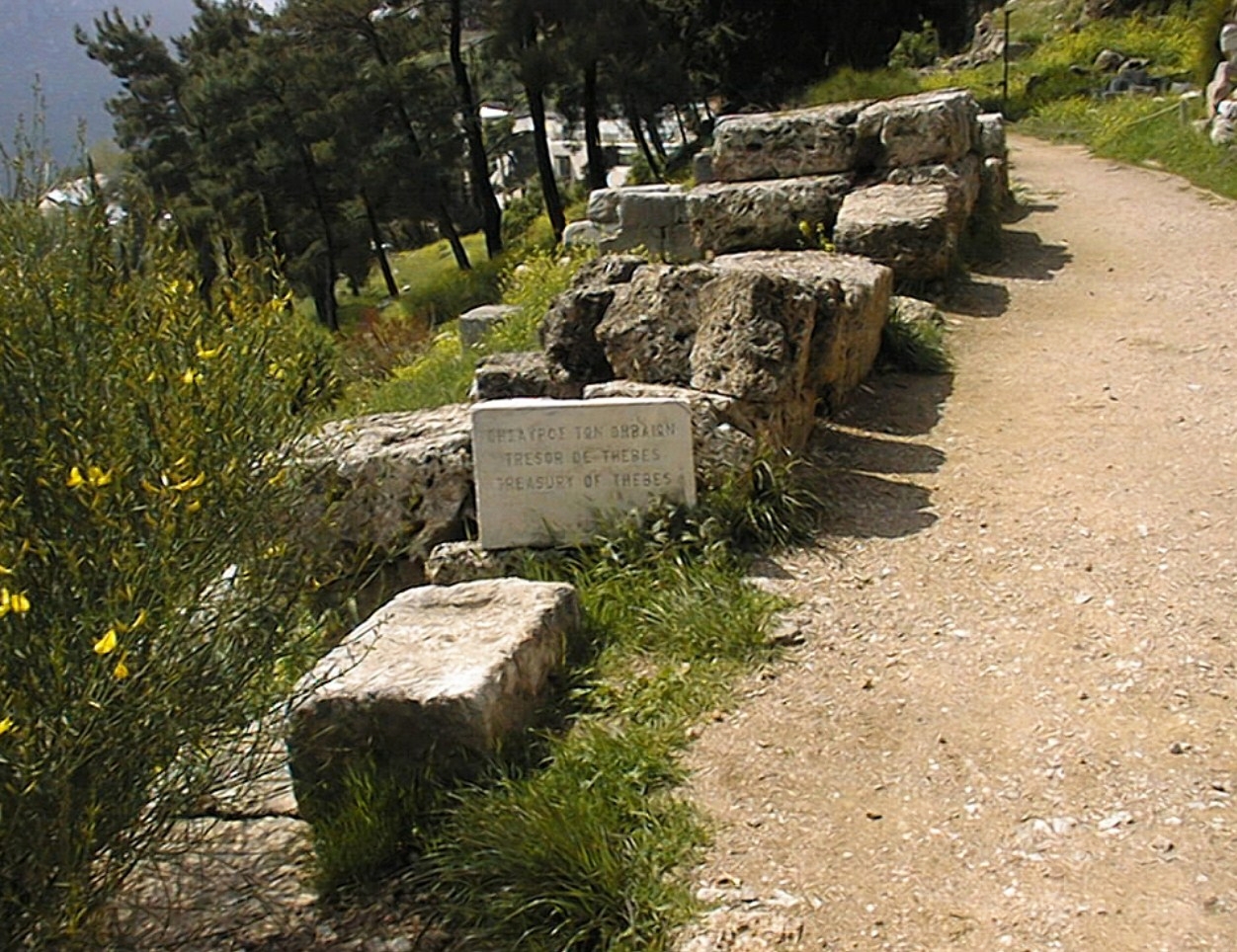Theban Treasury (Delphi) on:
[Wikipedia]
[Google]
[Amazon]
 The Treasury of the Thebans at
The Treasury of the Thebans at
 The Treasury of the Thebans at
The Treasury of the Thebans at Delphi
Delphi (; ), in legend previously called Pytho (Πυθώ), in ancient times was a sacred precinct that served as the seat of Pythia, the major oracle who was consulted about important decisions throughout the ancient classical world. The oracle ...
was built in the Doric order
The Doric order was one of the three orders of ancient Greek and later Roman architecture; the other two canonical orders were the Ionic and the Corinthian. The Doric is most easily recognized by the simple circular capitals at the top of col ...
and made entirely out of local limestone from the quarries of St. Elias close to the town of Chrisso. It was situated a few meters below the first turn of the Sacred Way
The Sacred Way ( grc, Ἱερὰ Ὁδός, ''Hierá Hodós''), in ancient Greece, was the road from Athens to Eleusis. It was so called because it was the route taken by a procession celebrating the Eleusinian Mysteries. The procession to Eleus ...
, the processional route in the sanctuary of Apollo
Apollo, grc, Ἀπόλλωνος, Apóllōnos, label=genitive , ; , grc-dor, Ἀπέλλων, Apéllōn, ; grc, Ἀπείλων, Apeílōn, label=Arcadocypriot Greek, ; grc-aeo, Ἄπλουν, Áploun, la, Apollō, la, Apollinis, label= ...
. It had been dedicated by the Thebans
Thebes (; ell, Θήβα, ''Thíva'' ; grc, Θῆβαι, ''Thêbai'' .) is a city in Boeotia, Central Greece. It played an important role in Greek myths, as the site of the stories of Cadmus, Oedipus, Dionysus, Heracles and others. Archaeolog ...
for their victory against the Lacedaemonians
Sparta (Doric Greek: Σπάρτα, ''Spártā''; Attic Greek: Σπάρτη, ''Spártē'') was a prominent city-state in Laconia, in ancient Greece. In antiquity, the city-state was known as Lacedaemon (, ), while the name Sparta referred t ...
at Leuctra
Leuctra or Leuktra ( grc, τὰ Λεῦκτρα, tà Leûktra, grc, τὸ Λεῦκτρον, tò Leûktron, label=none ) was a village of ancient Boeotia, situated on the road from Thespiae to Plataea, and in the territory of the former city. I ...
(371 BC).
Description
Shortly after their victory against the Lacaedemonians at theBattle of Leuctra
The Battle of Leuctra ( grc-gre, Λεῦκτρα, ) was a battle fought on 6 July 371 BC between the Boeotians led by the Thebans, and the Spartans along with their allies amidst the post-Corinthian War conflict. The battle took place in the vicin ...
in 371 BC, a landmark of the brief Theban supremacy in the political life of Greece, the Thebans dedicated at the sanctuary of Apollo a treasury
A treasury is either
*A government department related to finance and taxation, a finance ministry.
*A place or location where treasure, such as currency or precious items are kept. These can be state or royal property, church treasure or in p ...
built in the Doric order. It was the largest treasury in dimensions of Delphi, situated close to the SW corner of the sanctuary. Rectangular in plan, measuring 12.29 by 7.21 meters, it stood on a crepis
''Crepis'', commonly known in some parts of the world as hawksbeard or hawk's-beard (but not to be confused with the related genus ''Hieracium'' with a similar common name), is a genus of annual and perennial flowering plants of the family Aster ...
with two steps. It was constructed entirely out of local limestone from the quarries at St. Elias, a particularly hard stone with bluish-grey shades, which accentuates the austere style of the Doric building. Thus, the Treasury of the Thebans made a visual contrast to the nearby Siphnian Treasury
The Siphnian Treasury was a building at the Ancient Greek cult centre of Delphi, erected to host the offerings of the polis, or city-state, of Siphnos. It was one of a number of treasuries lining the "Sacred Way", the processional route throug ...
, with its colourful and decorative Ionian style. A frieze with metope
In classical architecture, a metope (μετόπη) is a rectangular architectural element that fills the space between two triglyphs in a Doric frieze, which is a decorative band of alternating triglyphs and metopes above the architrave of a bu ...
s and triglyph
Triglyph is an architectural term for the vertically channeled tablets of the Doric frieze in classical architecture, so called because of the angular channels in them. The rectangular recessed spaces between the triglyphs on a Doric frieze are ...
s ran all around the building.
Several opinions have been expressed regarding its actual architectural form. The current views, however, suggest that it was a uniform building, without columns, possibly with two entrances on the narrow sides and with a vertical wall functioning as boulder. An opening along the western wall provided natural lighting in the building.Jacquemin.A., Laroche, D., « Note sur quatre édifices d’époque classique à Delphes», BCH 136-137, 2012-2013, 106-114
References
{{reflist Ancient Greek buildings and structures in Delphi Ancient Thebes (Boeotia) Votive offering Buildings and structures completed in the 4th century BC